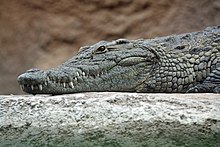
Back ኣዞ Amharic تمساح ARZ تیمساح AZB Buaya BCL Bajul BEW কুমির Bengali/Bangla تیمساح CKB Nyɛbiga DAG Ɛbaa DGA Nyaŋ DIN
| Crocodylia Temporal range: Upper Cretaceous – Holocene, 94–0 mya
| |
|---|---|

| |
| Nile crocodile (Crocodylus niloticus) | |

| |
| Saltwater crocodile (Crocodylus porosus) | |
| Scientific classification | |
| Domain: | Eukaryota |
| Kingdom: | Animalia |
| Phylum: | Chordata |
| Class: | Reptilia |
| Clade: | Eusuchia |
| Order: | Crocodilia Cuvier, 1807 |
| Type species | |
| Crocodylus niloticus Laurenti, 1768
| |
| Genera | |
| |
A crocodile is a large amphibious reptile. It lives mostly in large tropical rivers, where it is an ambush predator.
The Crocodylia is an order of mostly large, predatory, semiaquatic reptiles. Their ancestors, the clade Pseudosuchia, appeared about 250 million years ago in the early Triassic period.
Crocodiles as we know them first appeared 94 million years ago in the Upper Cretaceous period. They are the closest living relatives of birds: the two groups are the only survivors of the Archosauria.
One species, the Australian saltie, travels in coastal salt water as well as rivers. In very dry climates, crocodiles may aestivate and sleep out the dry season.
They are basically Archosaurs, a group which also includes the dinosaurs. There are various species of crocodiles including the American, slender-snouted and Orinoco crocodile.
The crocodile can quickly snap its jaw shut with much power. However, crocodiles have little strength when opening their jaws, such that a person can hold the jaw shut with their hands.
Present-day crocodiles range in size from African dwarf crocodiles that measure rarely over 5 feet (1.5 m) to saltwater crocodiles which can approach 23 feet (7 m).
